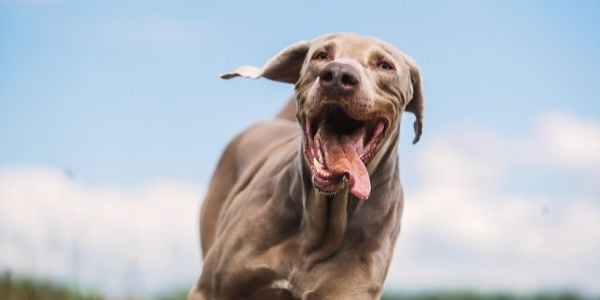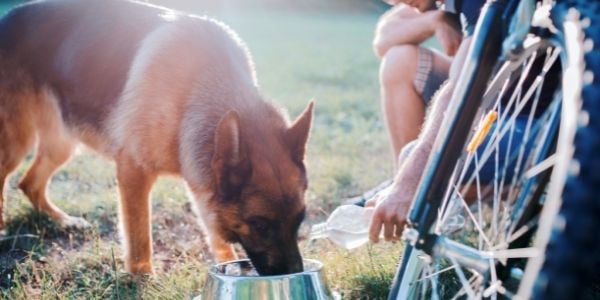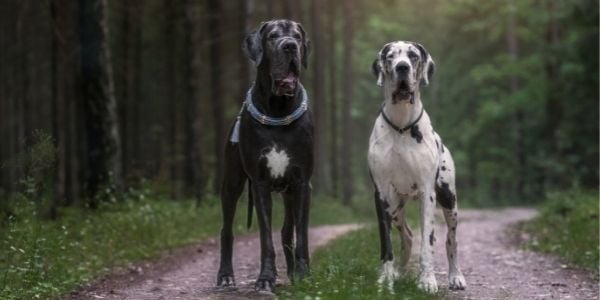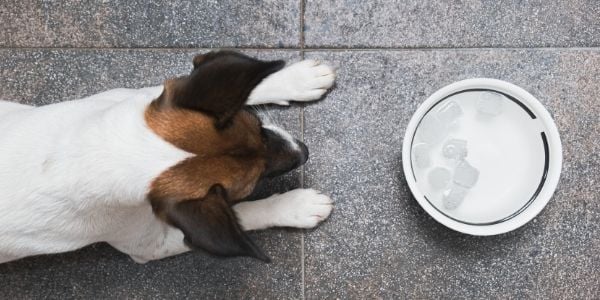 Bloat, also known as GDV or Gastric Dilatation Volvulus, is a serious condition primarily seen in large, deep-chested dogs and is considered a serious emergency in veterinary medicine.
Bloat, also known as GDV or Gastric Dilatation Volvulus, is a serious condition primarily seen in large, deep-chested dogs and is considered a serious emergency in veterinary medicine.
Therefore, if you believe your dog is suffering from bloat, please take your dog immediately to a veterinarian for assessment.
What Can Cause GDV?
Research is ongoing; therefore, all of the possible causes or contributing factors are unfortunately still unknown or under investigation. However, although there is still much to learn, we do know that several factors may contribute to one dog developing GDV over another, including the causes listed below.
- Breed: Breed plays a large role in the development of GDV. GDV typically affects large-sized, deep-chested dogs. However, some breeds are more predisposed than others to the condition. See the section on breed predisposition and the list of common breeds that suffer from GDV further on in this article.
- Family history of GDV: Especially if there is or was a first-degree relative who suffered from an episode of GDV, such as a littermate or parent. If you know your dog's breeder, asking them if this has ever been an issue for their breeding dogs and/or offspring is a good way to know if your dog could potentially be at risk in the future.
- Stress, anxiousness, or nervousness: (particularly when eating) may predispose a dog to an episode of GDV. Breeds that are more anxious or have a more highly strung personality may be more likely to experience a GDV event.
- Frequency and amount of food fed: Feeding one large meal per day may result in an exaggerated weighing down of the stomach, resulting in excessive stretch being placed on the hepatogastric ligament, which is the ligament responsible for maintaining the stomach's normal position within the abdomen. Once this ligament has been stretched excessively, it allows the stomach to move more freely within the abdomen, including the freedom to rotate on itself, which it ordinarily would be incapable of doing if the hepatogastric ligament were taut.

- Exercise and timing of food: Exercise, especially excessive, and then immediately feeding a dog may result in the dog swallowing large amounts of air while eating (as they are likely panting). This air fills up in the stomach, resulting in bloat and possibly GDV.
- Ingestion of large volumes of water: Drinking a lot at one time (particularly during, before, or after exercise) may increase the amount of air swallowed (similar to feeding after exercise).
- Comorbidities: Conditions that decrease intestinal motility, such as inflammatory bowel disease, food allergies, previous gastrointestinal surgery, and others, may result in the dysregulation of a dog’s gastric motility (i.e., movement of food through the intestines) and consequently may cause an episode of GDV.
- Being underweight or thin: GDV is said to occur more commonly in underweight and/or thin/lean dogs than in overweight ones. The reason for this is still being investigated. However, it has been hypothesized that this is because overweight or fat dogs have less space in their abdomen for their stomach to fill with gas and ultimately rotate.
Whereas a thin, lean, or underweight dog has a decreased amount of fat within their abdomen, increasing the amount of room their stomach has to move around and fill with gas.
This does not, however, mean, under any circumstances, that you should overfeed your dog in an attempt to make them overweight so that this *may* decrease their chance of developing GDV.
Overweight dogs face a multitude of other health problems that lean or ideal weighing dogs are less likely to suffer from, such as diabetes, arthritis, and other joint diseases, ligament ruptures or tears, as well as many others. - Age: See the section below for which aged dogs are more susceptible to this condition.
- Gender: Males are more at risk than females; as to why this is, this hasn’t been determined as of yet. However, it has been suggested that it is due to their larger size and deeper chests. Studies are ongoing.
-
Diet: Although research into the causation and link between specific dietary factors and the development of GDV continues, there have been some commonly identified factors when it comes to what a dog is fed and the development of GDV.
Feeding dry food has been continuously linked more and more recently to the development of GDV in dogs. Additionally, if the dry food fed contains citric acid as a preservative, and is slightly moistened before feeding, the risk for developing GDV increases. One study said this caused a 320% increase in risk for developing bloat.
Additionally, feeding dry food that contains oil or fat as one of the first 4 ingredients has also been shown to be a common denominator in the development of GDV, increasing the risk by approximately 170%, according to that same study.However, as of yet, the brand of dog food fed has not been linked to the development of GDV.
Age of Dog
As with most animals, with age comes an increase in the development of various diseases. And this is no different when it comes to GDV/bloat.
Bloat/GDV in older, larger breed dogs
For large breeds, after they reach 5 years of age, the risk of developing GDV/bloat has been said to increase by approximately 20% each year as they get older. Whereas with giant breeds, after they reach only 3 years of age, the risk for them developing this condition is said to also increase by approximately 20% each year older they get.
In one recent study, dogs aged above 7 years old were the highest risk group for developing GDV.
This study indicated that this was perhaps due to an increase in comorbidities experienced by older dogs, particularly those involving the gastrointestinal system, such as inflammatory bowel disease (IBD)) as well as a slowing down of their gastrointestinal tract (decreased gastric motility) and decreased gastrointestinal tone, resulting in a greater amount of gas build-up, which is a pre-requisite to the development of GDV.
Additionally, ligament laxity increases with age. If the hepatogastric ligament that holds the stomach in place becomes laxer as a dog ages, the greater the ability the stomach has to rotate on itself, resulting in torsion and GDV.
"Uncomplicated" bloat or gastric dilatation in older, smaller dogs
Uncomplicated bloat is when the stomach fills up with gas but doesn't twist (dilatation without volvulus), and this has been reported to occur more commonly in elderly smaller-breed dogs.
Again, these facts were extrapolated to be due to the decreased motility and tone of the gastrointestinal system in older dogs, resulting in a greater gas build-up, as well as increased comorbidity being suffered by dogs over the age of 7 years.
Bloat/GDV can happen to puppies
Unfortunately, puppies are not completely in the clear when it comes to GDV/bloat. Some puppies inhale their food at a pace equal to that of a land-speed record, resulting in the inhalation of larger amounts of air.
And they're notorious for gorging themselves on water (it’s a game for most puppies!) and then running around at all hours – before and after eating – despite our best efforts at controlling this.
Although puppies, from the age when we first bring them home to around 1 year, are less likely to suffer from GDV than dogs over the age of 1. The reasons are that they are likely to be suffering from less (if any) comorbidities and their superior gastrointestinal motility and tone compared to that of older dogs.
Some Dog Breeds Are at Higher Risk for Developing GDV

A dog's breed is known as the most significant risk factor when it comes to which dog(s) may suffer from GDV. Theoretically, any dog can suffer from GDV/bloat; however, typically, dogs that are at higher risk for developing GDV are large and giant breed dogs and those with deep or barrel-shaped chests.
Although this isn't an exhaustive list of all dog breeds that may suffer from GDV, it is instead a comprehensive list of the most common breeds bloat typically affects:
- Akita
- Basset Hound
- Bernese Mountain Dog
- Borzoi
- Boxer
- Doberman Pinscher
- Dogue De Bordeaux
- German Shepherd
- German Shorthaired Pointer
- Gordon Setter
- Great Dane
- Irish Setter
- Irish Wolfhound
- Labrador Retriever
- Old English Sheepdog
- Saint Bernard
- Standard Poodle
- Weimaraner
In a recent study, the three most likely breeds at risk of bloat were the Great Dane, Saint Bernard, and Weimaraner. However, it must again be noted that ANY dog or dog breed can develop GDV/bloat, including small breed dogs such as Shih Tzu’s, Pomeranians, and even Chihuahuas.
Mixed Breeds and GDV/Bloat
It must also be mentioned that mixed-breed dogs can and do suffer from GDV/bloat as well; however, their risk of developing GDV is lower than that of pure-bred large-breed dogs such as those listed above.
This is likely due to their genetic makeup decreasing their predisposition for this condition.
Prevention for dog breeds predisposed to GDV
Many veterinarians will recommend to pre-emptively surgically ‘tack’ a predisposed dog’s stomach to the stomach wall, known as a ‘gastropexy’ or ‘pexy’ surgery.
This procedure is the actual emergency surgery performed when a patient suffers from GDV. Often, this surgery is recommended before a dog experiences an episode of bloat as a preventive or prophylactic measure and is typically performed when a young dog is being spayed or neutered. Read more about this surgery as an emergency procedure.
If you are the owner of a Great Dane, German Shepherd, Weimaraner, or similar breed, this surgery is almost always one I will personally recommend to prevent the possibility of GDV in your dog’s future.
However, it is not incorrect to discuss this preventative measure with your veterinarian if you own any large breed, deep-chested dog. Prevention, in this case, is far superior to having your dog potentially experience a life-threatening condition.

Ice Water Does Not Cause Bloat
Unfortunately, in one case back in 2007, a patient passed away after what the owner thought was bloat following the consumption of ice water. Surgery confirmed that the patient's stomach was not actually rotated as expected with GDV.
However, the dog health rumor mill became very concerned with ice water and its association with bloat or GDV. This has been dispelled as a true cause of GDV, as it has not been able to be reliably repeated in any form of study into the causation of GDV in dogs.
As always, it is recommended that everything should be given in moderation, just like in people.
Please share your dog's experience with GDV/Bloat.
The survey is anonymous and takes 2–5 minutes. The information you share will help many more dogs.




